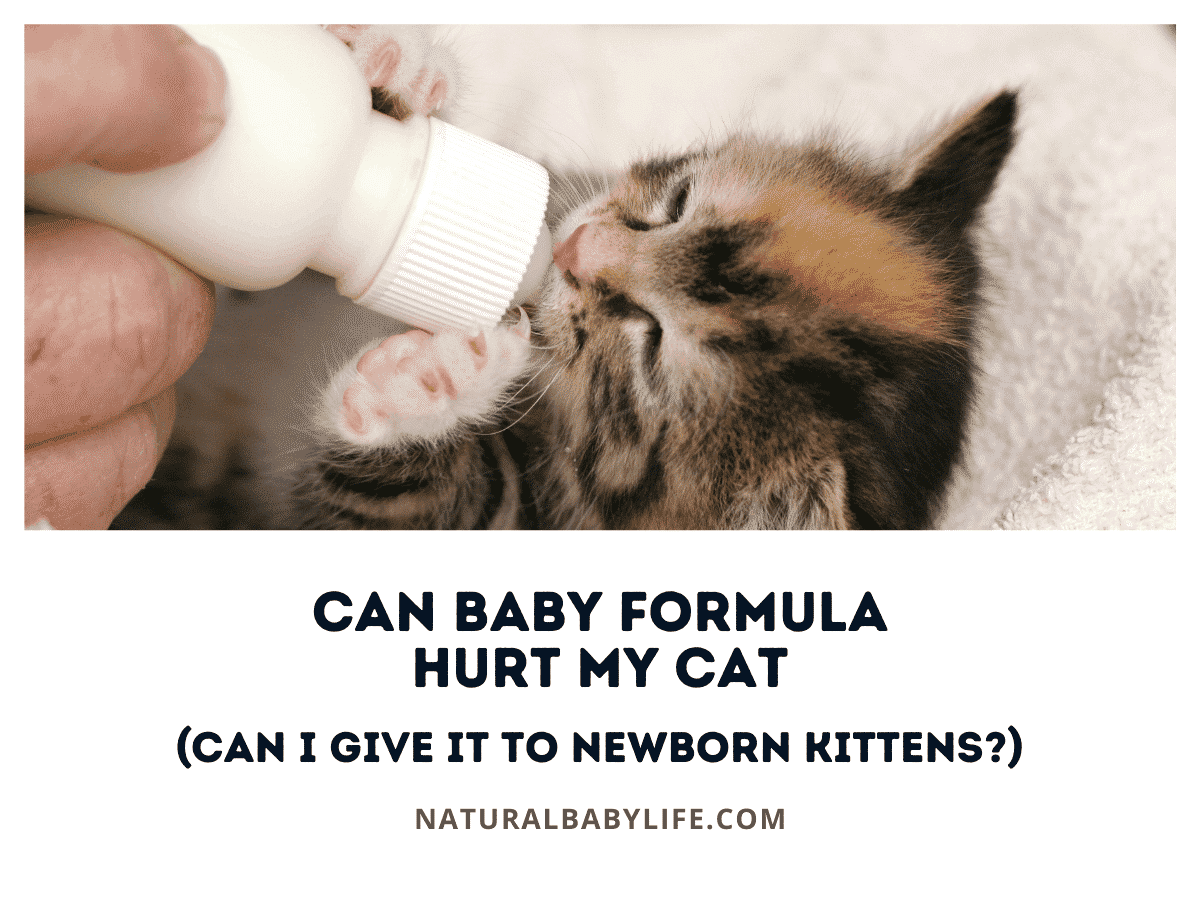If you have a cat and a toddler at home, you may have thought “my toddler is mean to our cat! What do I do?” Hitting, tail pulling, chasing, and squishing are all behaviors commonly seen in interactions between toddlers and cats, but when should you worry?
In most cases, toddlers are mean to the cat because they’re trying to play but they don’t understand that the cat is a living thing that might not want to play. Once toddlers learn that a certain action will create a response, they will do it over and over again while experimenting and testing their limits.
Let’s look at some of the reasons your child might act this way towards your cat and discuss some options for addressing this behavior.
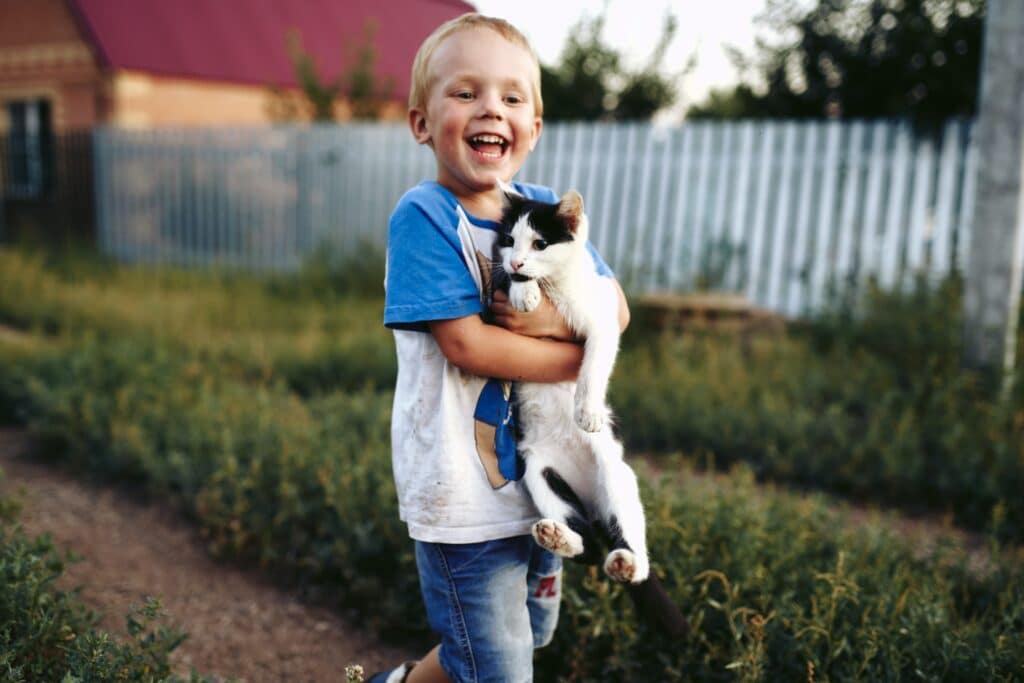
Table of Contents
My toddler is mean to our cat: what do I do?
If you notice your toddler being mean to your cat, you might wonder what to do about it. Most of the time, toddlers are not intentionally trying to hurt the animal. They want to interact with your cat but they aren’t able to control themselves well enough to make good choices in these interactions.
Since toddlers and young children are still learning, it’s important to always supervise toddler/pet interactions, correct inappropriate behavior, and model gentle touch and play. If your toddler is mean to the dog, check out this article.
Let’s talk about the three most common reasons your toddler may be harassing your cat.
Toddlers are constantly experimenting with their environment
Toddlers learn through hands-on exploration. They hit, kick, grab, pull, and throw objects just to see what will happen. If they like what they see or hear, they do it again and again.
At first, a child may view a cat as just another toy – except this toy moves and makes noise on its own. It also reacts in surprising, and often funny, ways. This makes the child view the cat as a fascinating and enticing plaything.
Toddlers will often experiment with different touches just to see what the cat will do. They want to get a reaction, so gentle petting may quickly evolve into more forceful hitting and grabbing.
Depending on the cat’s temperament, this could have various consequences. Maybe the cat will just meow and put up with it, or your cat may bat at your toddler to try and make it stop. Some cats may run away, while others may decide to fight back with scratching and biting. If the toddler likes the reaction, they will likely try to make it happen again.
It is common for toddlers to test their limits
Eventually, your child will realize that the cat is not a toy but another living being.
However, this realization doesn’t always stop the behavior. Just like with their parents and siblings, toddlers often feel the need to test their limits with pets.
They want to know just how loud they can yell in their cat’s ear before it runs away or how long they can lay on the cat before mommy comes to the rescue. They want to know what is acceptable and what is not.
Toddlers are still learning that it’s not okay to harm others and need to test their limits to find out the difference between right and wrong. This is a normal part of the learning process, but it’s important that you start to teach your child about how they can be gentle with cat or other pets.
Toddlers are still learning self-control and empathy
Even as a child begins to learn gentle and kind ways to interact with a cat, they may still randomly strike out at the animal for no apparent reason.
Toddlers have little to no impulse control and when they are excited or bored they may hit, kick, throw objects, or scream despite having been taught more appropriate behaviors. Research shows that most children start to develop better self-control between the ages of 3 and 9.
Toddlers also have “big” emotions which they often don’t know how to process. Anger and frustration frequently lead to hitting, kicking, or biting. They might even be fearful and clingy. But happiness and excitement may also prompt these actions. Therefore, even as toddlers are learning to be gentle, they may still act without thinking and they still require supervision when dealing with animals.
Is it normal for toddlers to be mean to pets?
If your toddler is frequently mean to your cat, you might wonder if this is a normal interaction. In most cases, it is normal. Hitting, slapping, and pulling the cat’s tail may all be normal actions when your toddler is pushing boundaries.
There is a difference between normal toddler behavior and animal cruelty, which we’ll discuss more in-depth later on. If your toddler’s behavior gets better as you teach them to be gentle with your cat or pet, then it’s likely nothing to be concerned about.
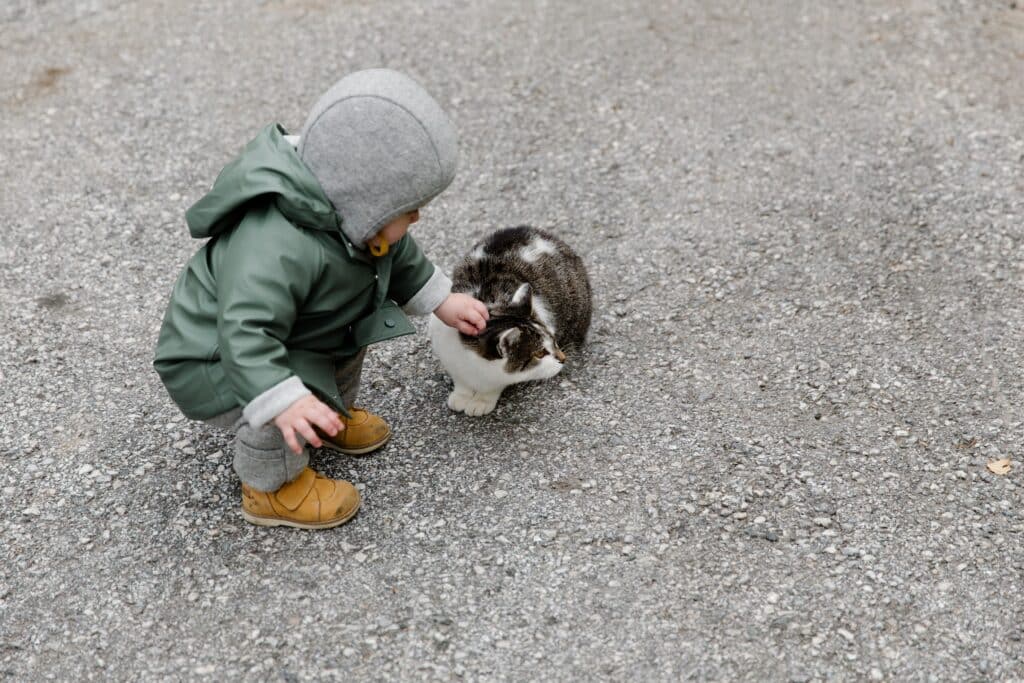
How do I get my toddler to be nice to the cat?
Teaching your child to be kind and gentle with your cat can be a lengthy process. Even as they learn, they are likely to forget or get caught up in their emotions and act without thinking. It can be difficult to closely supervise every single moment of interaction between your toddler and your cat. So, what can you do?
Here are some typical interactions that may occur between your toddler and your cat and how you can deal with them.
My child won’t leave the cat alone
Just because your toddler wants to play, doesn’t mean your cat does. However, young children don’t understand that and will frequently terrorize the poor animal anytime they’re near. The best thing you can do for your cat in this case is provide a safe space for the cat to escape when they want to be left alone.
That’s why it’s important to have an area in your home that’s a safe space for the cat. This means that there should be ample room for the cat to freely play, move around, and feel comfortable near your toddler so that your cat isn’t too anxious.
Some examples of safe spaces can be a cat tree, access to tops of furniture, or a gated-off section of the house. Make sure your cat trees and furniture are secured to the wall and the lowest shelves or ladder are removed in case your child tries to climb up after the cat. If your cat is older and unable to jump or climb well, consider a baby gate with a cat door.
What if your toddler is chasing the cat
Cats don’t like to be chased – although this may seem like great fun to young children.
For very young toddlers, it’s best to redirect – “kitty doesn’t want to be chased, but you can chase me.” As they grow older, you can try explaining that the cat is scared and wants to hide. You can also model and practice approaching a cat slowly.
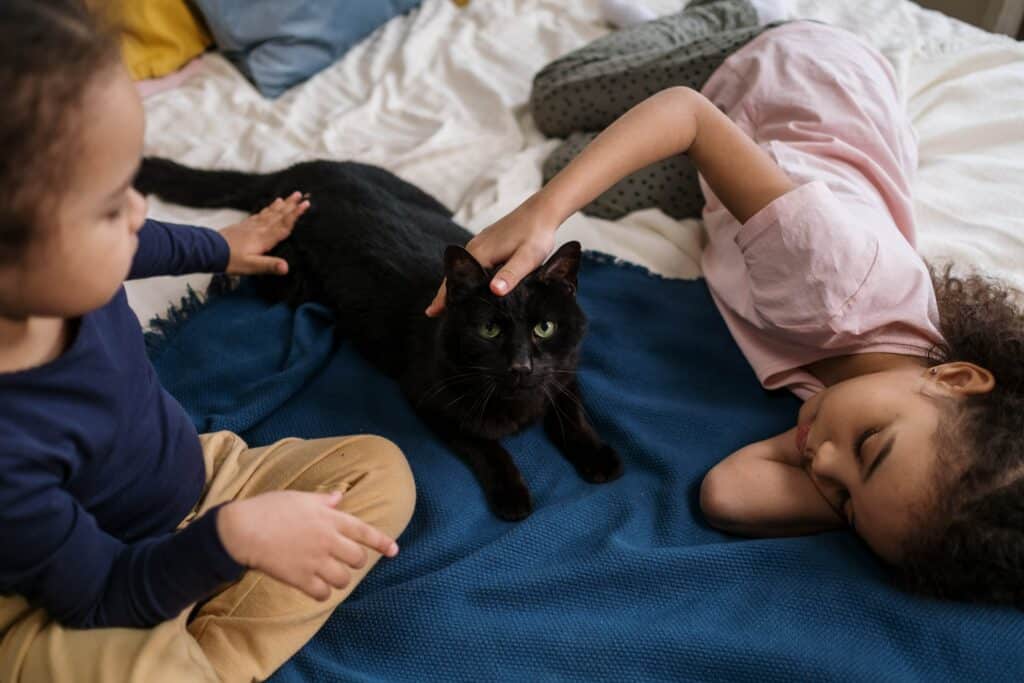
When your child is hitting the cat
One of the best ways to prevent rough behavior from your toddler is to practice gentle petting with your toddler. Watch for signs that your cat is in the mood to interact and invite your child to sit with you near the cat.
Model appropriate petting and use the words “gentle” and “nice hands.” Invite your child to try petting nicely. If necessary, guide them with hand-over-hand teaching. Comment on how happy the cat is, listen for purring, and praise your child for being gentle.
Later, you can use the words “gentle” and “nice hands” as a reminder when your child is near the cat or starts hitting the cat. Repeated modeling and practice may be necessary.
Continue to offer praise when your child remembers to be gentle. If your child continues to hit, you may need to redirect your child and move the cat to its safe space and try again later.
What if your toddler is throwing things at the cat
Toddlers like to throw things and it’s a skill they do need to learn and practice. However, they also need to know that certain things are not meant for throwing and that there are certain times and places when throwing is not appropriate.
If your child throws something and it accidentally hits the cat, you should point out that the cat was hurt and scared – use it as a moment to teach empathy. Then redirect your child’s need to throw things by inviting a game of catch or bean bag toss.
If your child is throwing things at the cat in anger, encourage empathy, but also try to help your child work through their feelings. Direct punishment may have a negative effect because your child may blame the cat for the punishment and lash out at the animal again later.
You may also consider removing the object they threw, especially if it is a continuous occurrence with the same object.
My 2-year-old is mean to the cat
As your toddler grows older, their understanding of right and wrong will grow as well. It will also become easier to discuss empathy with your child and to teach various ways that a cat could be injured. Keep in mind it will take time for your child to fully comprehend these ideas.
A 2-year-old still has very poor impulse control. Aggressive behavior also tends to peak around age 2 as they struggle to find ways to express themselves with limited language skills. During this time, it is important to help your child deal with their emotions and to consistently model appropriate ways to interact with your cat.
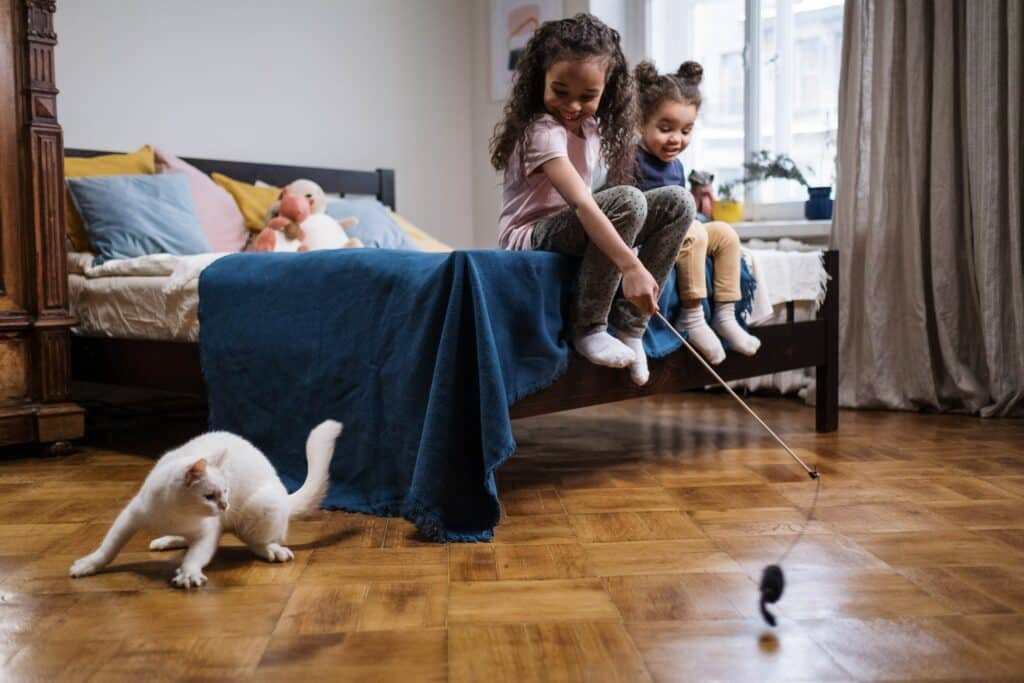
My 3-year-old is mean to the cat
At 3-years-old, your child is beginning to develop better self-control but still has a way to go before they can be trusted alone with your cat. However, at 3 years old, your child has stronger language skills and can be encouraged to use words to express strong emotions.
This is also a great period for modeling and practicing appropriate interactions with your cat. Try inventing some pretend vet play with stuffed animals to encourage care and empathy.
My 4-year-old is mean to the cat
Your 4-year-old may be ready to take on some simple responsibilities in helping to care for your cat. Try having your child help with feeding and filling the water bowl. Your child may also enjoy brushing your cat – another opportunity to teach careful and slow motions in an activity that the cat may also enjoy.
Taking part in the care of a pet may help your child form a deeper bond with the animal and be more likely to treat your cat with kindness.
What does it mean if a child is cruel to animals?
While young children are still learning to treat animals humanely, it can be difficult to tell if their actions are simply “normal toddler behavior” or if they are a symptom of something worse. Some parents may worry that their child’s cruel treatment of the family pet may be a warning sign of future criminal behavior.
Research has consistently reported that most criminals have some history of animal cruelty, but at what point should we worry?
Although more research has been done regarding animal cruelty in older children, there are some indications that a toddler’s behavior is not normal. The first things a parent must consider are the intensity, frequency, and motivation behind a child’s acts of aggression towards animals.
How to know when the behavior is normal
Some questions you might ask yourself when determining if your child’s behavior is normal are:
- Is the child causing significant harm to the animal?
- Is the child frequently seeking out the animal to cause harm or simply reacting when the animal is already in the room?
- Does the child stop when prompted or redirected?
Motivation can be difficult to determine in a toddler, but animal cruelty in very young children is most often motivated by some form of curiosity, as discussed above. However, the likelihood of actual animal abuse increases if a child has been exposed to violence.
Witnessing abuse or being a victim of abuse may cause children to act out similarly against their pets. If you know or suspect that a child has been exposed to violent acts, it is important to watch for these signs and get help right away.
Frequently Asked Questions (FAQs)
How do I get my child to stop tormenting my pet?
If your child is tormenting your pet, most of the time they don’t understand what they’re doing. One of the best ways to correct this behavior is by modeling the proper behavior and how to gently handle to pet.
Why is my 2-year-old mean to animals?
2-year-olds don’t have the self-control that older children have. This can lead to them being mean to a cat for a number of different reasons. While they likely aren’t trying to hurt the cat, they may hit, slap, or pull on the cat when they get upset and don’t have a better way to express their emotions.
Conclusion
Having a toddler and a cat in the same home can be a challenge, but there are many ways to help them get along. If you find that your toddler is frequently being mean to your cat, it’s likely they’re just testing boundaries and learning how to interact properly. Modeling the correct behavior can go a long way when it comes to teaching your child.

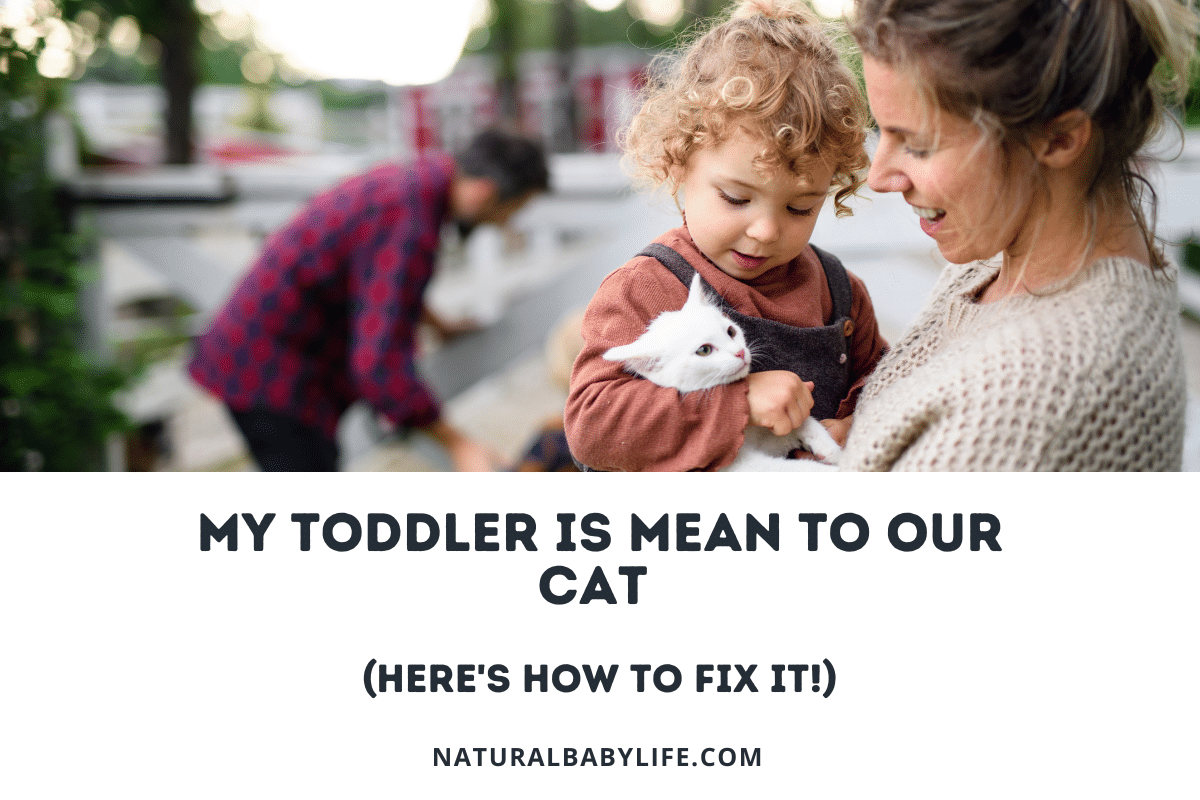

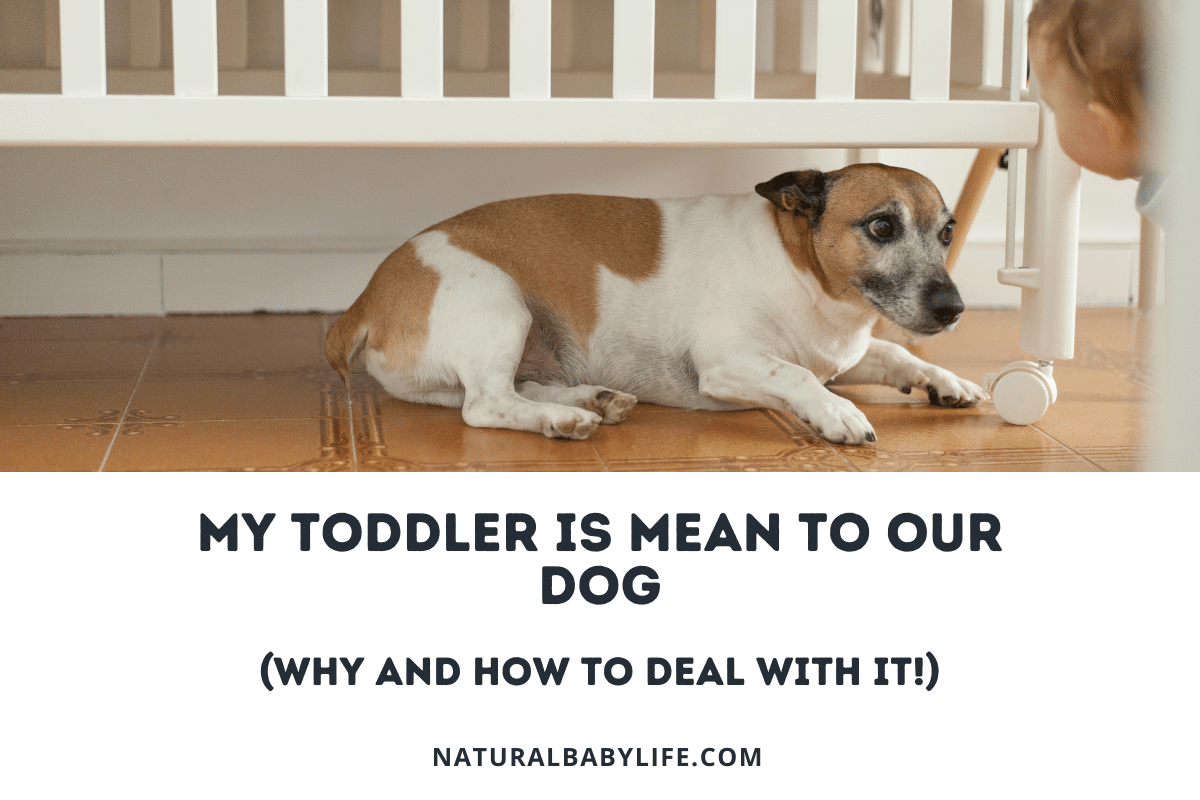
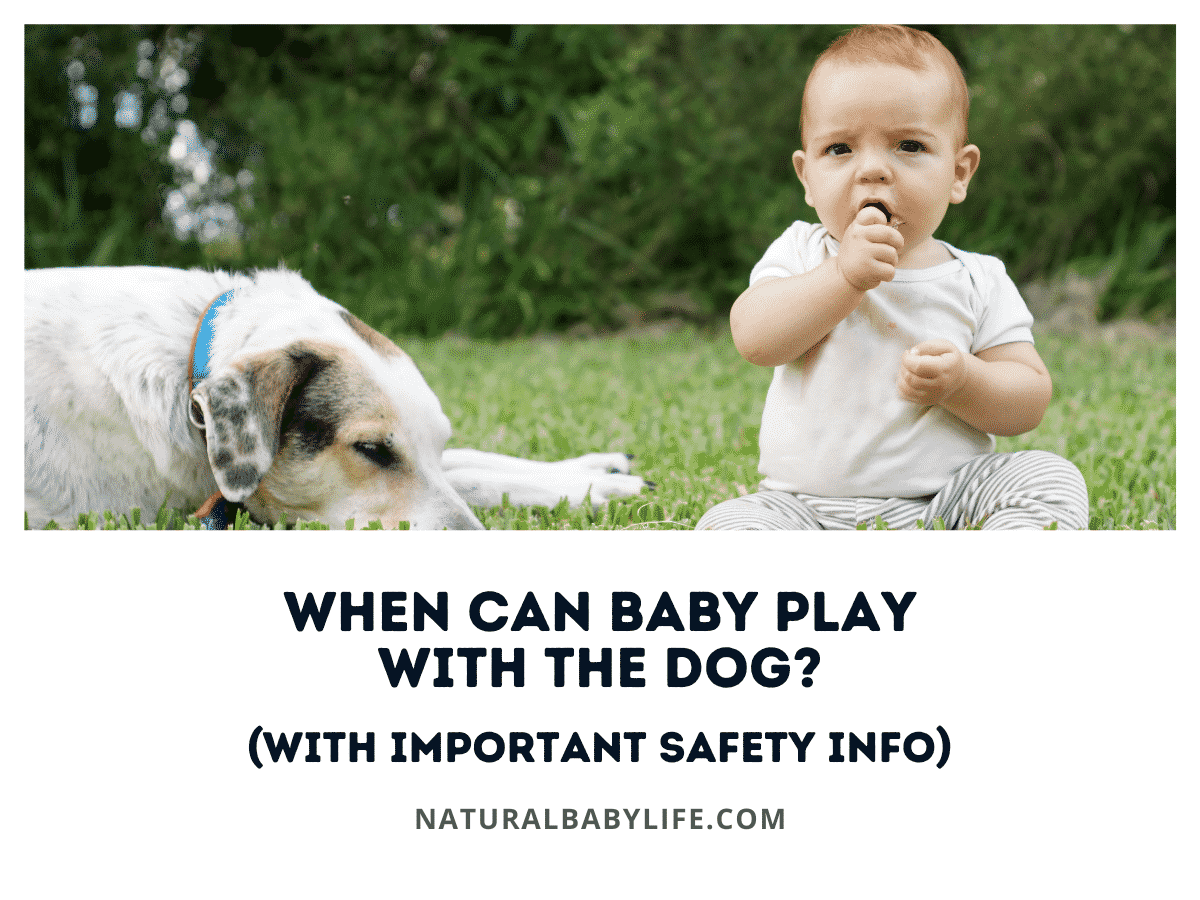
![A Dog Licked My Baby [Head, Face, Eye, Hand] Is It Cute or Dangerous?](https://naturalbabylife.com/wp-content/uploads/2021/04/dog-licked-babys-eye-head-face-hand_featured.png)
